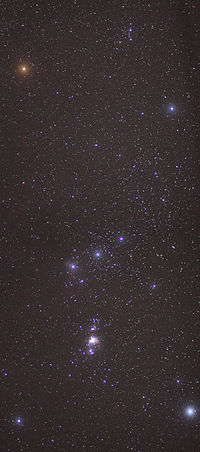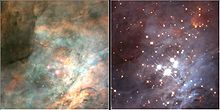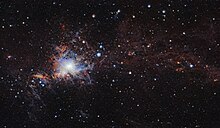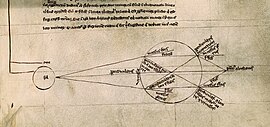| Diffuse nebula | |
|---|---|
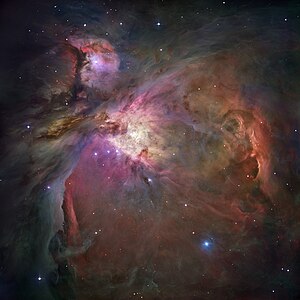
The entire Orion Nebula in a composite image of visible light and infrared
| |
| Observation data: J2000 epoch | |
| Subtype | Reflection/Emission |
| Right ascension | 05h 35m 17.3s |
| Declination | −05° 23′ 28″ |
| Distance | 1,344±20 ly (412 pc) |
| Apparent magnitude (V) | +4.0 |
| Apparent dimensions (V) | 65×60 arcmins |
| Constellation | Orion |
| Physical characteristics | |
| Radius | 12 ly |
| Absolute magnitude (V) | — |
| Notable features | Trapezium cluster |
| Designations | NGC 1976, M42, LBN 974, Sharpless 281 |
The Orion Nebula (also known as Messier 42, M42, or NGC 1976) is a diffuse nebula situated in the Milky Way, being south of Orion's Belt in the constellation of Orion. It is one of the brightest nebulae, and is visible to the naked eye in the night sky. M42 is located at a distance of 1,344 ± 20 light years and is the closest region of massive star formation to Earth. The M42 nebula is estimated to be 24 light years across. It has a mass of about 2,000 times that of the Sun. Older texts frequently refer to the Orion Nebula as the Great Nebula in Orion or the Great Orion Nebula.
The Orion Nebula is one of the most scrutinized and photographed objects in the night sky, and is among the most intensely studied celestial features. The nebula has revealed much about the process of how stars and planetary systems are formed from collapsing clouds of gas and dust. Astronomers have directly observed protoplanetary disks, brown dwarfs, intense and turbulent motions of the gas, and the photo-ionizing effects of massive nearby stars in the nebula.
Physical characteristics
Amateur image of the Orion Nebula taken with a Sony Alpha a6300 camera
Orion
Nebula and the Running man Nebula with surrounding nebulosity.
Composite of narrowband (SII + Ha + OIII) and RGB with an 80mm
telescope.
The constellation of Orion with the Orion Nebula (lower middle)
The nebula is visible with the naked eye even from areas affected by some light pollution.
It is seen as the middle "star" in the "sword" of Orion, which are the
three stars located south of Orion's Belt. The star appears fuzzy to
sharp-eyed observers, and the nebulosity is obvious through binoculars or a small telescope. The peak surface brightness of the central region is about 17 Mag/arcsec2 (about 14 millinits) and the outer bluish glow has a peak surface brightness of 21.3 Mag/arcsec2 (about 0.27 millinits). (In the photos shown here the brightness, or luminance, is enhanced by a large factor.)
The Orion Nebula contains a very young open cluster, known as the Trapezium due to the asterism of its primary four stars. Two of these can be resolved into their component binary systems on nights with good seeing, giving a total of six stars. The stars of the Trapezium, along with many other stars, are still in their early years. The Trapezium is a component of the much larger Orion Nebula Cluster, an association of about 2,800 stars within a diameter of 20 light years. Two million years ago this cluster may have been the home of the runaway stars AE Aurigae, 53 Arietis, and Mu Columbae, which are currently moving away from the nebula at speeds greater than 100 km/s.
Coloration
Observers
have long noted a distinctive greenish tint to the nebula, in addition
to regions of red and of blue-violet. The red hue is a result of the Hα recombination line radiation at a wavelength of 656.3 nm. The blue-violet coloration is the reflected radiation from the massive O-class stars at the core of the nebula.
The green hue was a puzzle for astronomers in the early part of the 20th century because none of the known spectral lines at that time could explain it. There was some speculation that the lines were caused by a new element, and the name nebulium was coined for this mysterious material. With better understanding of atomic physics, however, it was later determined that the green spectrum was caused by a low-probability electron transition in doubly ionized oxygen, a so-called "forbidden transition".
This radiation was all but impossible to reproduce in the laboratory at
the time, because it depended on the quiescent and nearly
collision-free environment found in the high vacuum of deep space.
History
Messier's drawing of the Orion Nebula in his 1771 memoir, Mémoires de l'Académie Royale
There has been speculation that the Mayans of Central America
may have described the nebula within their "Three Hearthstones"
creation myth; if so, the three would correspond to two stars at the
base of Orion, Rigel and Saiph, and another, Alnitak at the tip of the "belt" of the imagined hunter, the vertices of a nearly perfect equilateral triangle with Orion's Sword (including the Orion Nebula) in the middle of the triangle seen as the smudge of smoke from copal
incense in a modern myth, or, in (the translation it suggests of) an
ancient one, the literal or figurative embers of a fiery creation.
Neither Ptolemy's Almagest nor Al Sufi's Book of Fixed Stars noted this nebula, even though they both listed patches of nebulosity elsewhere in the night sky; nor did Galileo mention it, even though he also made telescopic observations surrounding it in 1610 and 1617. This has led to some speculation that a flare-up of the illuminating stars may have increased the brightness of the nebula.
The first discovery of the diffuse nebulous nature of the Orion Nebula is generally credited to French astronomer Nicolas-Claude Fabri de Peiresc, on 26 November 1610 when he made a record of observing it with a refracting telescope purchased by his patron Guillaume du Vair.
The first published observation of the nebula was by the Jesuit mathematician and astronomer Johann Baptist Cysat of Lucerne in his 1619 monograph on the comets (describing observations of the nebula that may date back to 1611). He made comparisons between it and a bright comet seen in 1618 and described how the nebula appeared through his telescope as:
- one sees how in like manner some stars are compressed into a very narrow space and how round about and between the stars a white light like that of a white cloud is poured out
His description of the center stars as different from a comet's head
in that they were a "rectangle" may have been an early description of
the Trapezium Cluster (The first detection of three of the four stars of this cluster is credited to Galileo Galilei
in a February 4, 1617 although he did not notice the surrounding nebula
— possibly due to the narrow field of vision of his early telescope.)
The nebula was independently discovered by several other prominent astronomers in the following years, including by Giovanni Battista Hodierna (whose sketch was the first published in De systemate orbis cometici, deque admirandis coeli characteribus).
Charles Messier
first noted the nebula on March 4, 1769, and he also noted three of the
stars in Trapezium. Messier published the first edition of his catalog
of deep sky objects in 1774 (completed in 1771). As the Orion Nebula was the 42nd object in his list, it became identified as M42.
Henry Draper's 1880 photograph of the Orion Nebula, the first ever taken.
One
of Andrew Ainslie Common's 1883 photograph of the Orion Nebula, the
first to show that a long exposure could record new stars and nebulae
invisible to the human eye.
In 1865 English amateur astronomer William Huggins used his visual spectroscopy method to examine the nebula showing it, like other nebulae he had examined, was made up of "luminous gas". On September 30, 1880 Henry Draper used the new dry plate photographic process with an 11-inch (28 cm) refracting telescope to make a 51-minute exposure of the Orion Nebula, the first instance of astrophotography
of a nebula in history. Another set of photographs of the nebula in
1883 saw breakthrough in astronomical photography when amateur
astronomer Andrew Ainslie Common used the dry plate process to record several images in exposures up to 60 minutes with a 36-inch (91 cm) reflecting telescope
that he constructed in the backyard of his home in Ealing, outside
London. These images for the first time showed stars and nebula detail
too faint to be seen by the human eye.
In 1902, Vogel and Eberhard discovered differing velocities within the nebula and by 1914 astronomers at Marseilles
had used the interferometer to detect rotation and irregular motions.
Campbell and Moore confirmed these results using the spectrograph,
demonstrating turbulence within the nebula.
In 1931, Robert J. Trumpler noted that the fainter stars near the Trapezium
formed a cluster, and he was the first to name them the Trapezium
cluster. Based on their magnitudes and spectral types, he derived a
distance estimate of 1,800 light years. This was three times farther
than the commonly accepted distance estimate of the period but was much
closer to the modern value.
In 1993, the Hubble Space Telescope
first observed the Orion Nebula. Since then, the nebula has been a
frequent target for HST studies. The images have been used to build a
detailed model of the nebula in three dimensions. Protoplanetary disks have been observed around most of the newly formed stars in the nebula, and the destructive effects of high levels of ultraviolet energy from the most massive stars have been studied.
In 2005, the Advanced Camera for Surveys instrument of the
Hubble Space Telescope finished capturing the most detailed image of
the nebula yet taken. The image was taken through 104 orbits of the
telescope, capturing over 3,000 stars down to the 23rd magnitude,
including infant brown dwarfs and possible brown dwarf binary stars.
A year later, scientists working with the HST announced the first ever
masses of a pair of eclipsing binary brown dwarfs, 2MASS
J05352184–0546085. The pair are located in the Orion Nebula and have
approximate masses of 0.054 M☉ and 0.034 M☉
respectively, with an orbital period of 9.8 days. Surprisingly, the
more massive of the two also turned out to be the less luminous.
Structure
Optical
images reveal clouds of gas and dust in the Orion Nebula; an infrared
image (right) reveals the new stars shining within.
The entirety of the Orion Nebula extends across a 1° region of the sky, and includes neutral clouds of gas and dust, associations of stars, ionized volumes of gas, and reflection nebulae.
The Nebula is part of a much larger nebula that is known as the Orion Molecular Cloud Complex. The Orion Molecular Cloud Complex extends throughout the constellation of Orion and includes Barnard's Loop, the Horsehead Nebula, M43, M78, and the Flame Nebula.
Stars are forming throughout the entire Cloud Complex, but most of the
young stars are concentrated in dense clusters like the one illuminating
the Orion Nebula.
Orion A molecular cloud from VISTA reveals many young stars and other objects.
The current astronomical model for the nebula consists of an ionized (H II) region, roughly centered on Theta1 Orionis C, which lies on the side of an elongated molecular cloud in a cavity formed by the massive young stars.
(Theta1 Orionis C emits 3-4 times as much photoionizing light as the next brightest star, Theta2
Orionis A.) The H II region has a temperature ranging up to 10,000 K,
but this temperature falls dramatically near the edge of the nebula. The nebulous emission comes primarily from photoionized gas on the back surface of the cavity.
The H II region is surrounded by an irregular, concave bay of more
neutral, high-density cloud, with clumps of neutral gas lying outside
the bay area. This in turn lies on the perimeter of the Orion Molecular
Cloud. The gas in the molecular cloud displays a range of velocities and
turbulence, particularly around the core region. Relative movements are
up to 10 km/s (22,000 mi/h), with local variations of up to 50 km/s and
possibly more.
Observers have given names to various features in the Orion
Nebula. The dark lane that extends from the north toward the bright
region is called the "Fish's Mouth". The illuminated regions to both
sides are called the "Wings". Other features include "The Sword", "The
Thrust", and "The Sail".
Star formation
View of several proplyds within the Orion Nebula taken by the Hubble Space Telescope
Star Formation Fireworks in Orion
The Orion Nebula is an example of a stellar nursery
where new stars are being born. Observations of the nebula have
revealed approximately 700 stars in various stages of formation within
the nebula.
Recent observations with the Hubble Space Telescope have yielded the major discovery of protoplanetary disks within the Orion Nebula, which have been dubbed proplyds. HST has revealed more than 150 of these within the nebula, and they are considered to be systems in the earliest stages of solar system formation. The sheer numbers of them have been used as evidence that the formation of star systems is fairly common in the universe.
Stars form when clumps of hydrogen and other gases in an H II region
contract under their own gravity. As the gas collapses, the central
clump grows stronger and the gas heats to extreme temperatures by
converting gravitational potential energy to thermal energy. If the temperature gets high enough, nuclear fusion will ignite and form a protostar. The protostar is 'born' when it begins to emit enough radiative energy to balance out its gravity and halt gravitational collapse.
Typically, a cloud of material remains a substantial distance
from the star before the fusion reaction ignites. This remnant cloud is
the protostar's protoplanetary disk, where planets may form. Recent infrared observations show that dust grains in these protoplanetary disks are growing, beginning on the path towards forming planetesimals.
Once the protostar enters into its main sequence
phase, it is classified as a star. Even though most planetary disks can
form planets, observations show that intense stellar radiation should
have destroyed any proplyds that formed near the Trapezium group, if the
group is as old as the low mass stars in the cluster.
Since proplyds are found very close to the Trapezium group, it can be
argued that those stars are much younger than the rest of the cluster
members.
Stellar wind and effects
Once formed, the stars within the nebula emit a stream of charged particles known as a stellar wind. Massive stars and young stars have much stronger stellar winds than the Sun.
The wind forms shock waves or hydrodynamical instabilities when it
encounters the gas in the nebula, which then shapes the gas clouds. The
shock waves from stellar wind also play a large part in stellar
formation by compacting the gas clouds, creating density inhomogeneities
that lead to gravitational collapse of the cloud.
View of the ripples (Kelvin–Helmholtz instability) formed by the action of stellar winds on the cloud.
There are three different kinds of shocks in the Orion Nebula. Many are featured in Herbig–Haro objects:
- Bow shocks are stationary and are formed when two particle streams collide with each other. They are present near the hottest stars in the nebula where the stellar wind speed is estimated to be thousands of kilometers per second and in the outer parts of the nebula where the speeds are tens of kilometers per second. Bow shocks can also form at the front end of stellar jets when the jet hits interstellar particles.
- Jet-driven shocks are formed from jets of material sprouting off newborn T Tauri stars. These narrow streams are traveling at hundreds of kilometers per second, and become shocks when they encounter relatively stationary gases.
- Warped shocks appear bow-like to an observer. They are produced when a jet-driven shock encounters gas moving in a cross-current.
- The interaction of the stellar wind with the surrounding cloud also forms "waves" which are believed to be due to the hydrodynamical Kelvin-Helmholtz instability.
The dynamic gas motions in M42 are complex, but are trending out through the opening in the bay and toward the Earth. The large neutral area behind the ionized region is currently contracting under its own gravity.
There are also supersonic "bullets" of gas piercing the hydrogen clouds of the Orion Nebula. Each bullet is ten times the diameter of Pluto's
orbit and tipped with iron atoms glowing in the infra-red. They were
probably formed one thousand years ago from an unknown violent event.
Evolution
Panoramic
image of the center of the nebula, taken by the Hubble Telescope. This
view is about 2.5 light years across. The Trapezium is at center left.
Interstellar clouds like the Orion Nebula are found throughout galaxies such as the Milky Way.
They begin as gravitationally bound blobs of cold, neutral hydrogen,
intermixed with traces of other elements. The cloud can contain hundreds
of thousands of solar masses
and extend for hundreds of light years. The tiny force of gravity that
could compel the cloud to collapse is counterbalanced by the very faint
pressure of the gas in the cloud.
Whether due to collisions with a spiral arm, or through the shock wave emitted from supernovae,
the atoms are precipitated into heavier molecules and the result is a
molecular cloud. This presages the formation of stars within the cloud,
usually thought to be within a period of 10–30 million years, as regions
pass the Jeans mass
and the destabilized volumes collapse into disks. The disk concentrates
at the core to form a star, which may be surrounded by a protoplanetary
disk. This is the current stage of evolution of the nebula, with
additional stars still forming from the collapsing molecular cloud. The
youngest and brightest stars we now see in the Orion Nebula are thought
to be less than 300,000 years old, and the brightest may be only 10,000 years in age.
Some of these collapsing stars can be particularly massive, and can emit large quantities of ionizing ultraviolet
radiation. An example of this is seen with the Trapezium cluster. Over
time the ultraviolet light from the massive stars at the center of the
nebula will push away the surrounding gas and dust in a process called photo evaporation.
This process is responsible for creating the interior cavity of the
nebula, allowing the stars at the core to be viewed from Earth. The largest of these stars have short life spans and will evolve to become supernovae.
Within about 100,000 years, most of the gas and dust will be
ejected. The remains will form a young open cluster, a cluster of
bright, young stars surrounded by wispy filaments from the former cloud.


